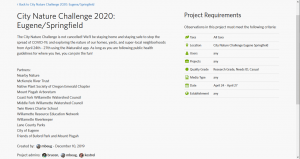Eugene City Nature Challenge 2020
This last weekend was the 2020 City Nature Challenge. I blogged about the event last year, but it is such great event that I am covering it again this year. It involves the organismal data base iNaturalist. This single free data-source is now opening the window for a plethora of new amateur naturalists to learn about the flora and fauna around them. If someone wants to learn about fish, about moss species, about lichens, even little single celled organisms, iNaturalist can help. It runs on a cell phone and all a user needs to do is to take a picture of the living thing she or he wants to identify, and the program will analyze the image in seconds and give the user a best guess at what it is. University of Oregon students could then use one our ecologically oriented databases like BioOne or Zoological Record to learn more. For a more historical overview of any of the species there is also the Biodiversity Heritage Library Database.
Many people in the Pacific Northwest will recognize this California Scrub Jay I saw and photographed over the weekend.
But what about this lepidopteran?
It’s a Propertius Duskywing (Erynnis propertius). It’s small, dark, fast, and not so easily identified. However, it was no problem for the iNaturalist Database
So here are the results:
This year I was able to double the number of species I could find (262+). Whether you adhere to 4, 7 or 8 Kingdoms of life I was able to find species from four (animalia, plantae, fungi, and bacteria).
Within the animal kingdom I was able to find and identify species from five of six classes of vertebrates (mammals, birds, reptiles, amphibians, and fish) found in the Eugene area. I did miss out on the finding any of our local lamprey, a jawless class of vertebrates known as the agnatha. I also found organisms in three other phyla, Mollusca (bivalvia and gastropoda), Arthropoda (insecta and Arachnida) and Annelida.







